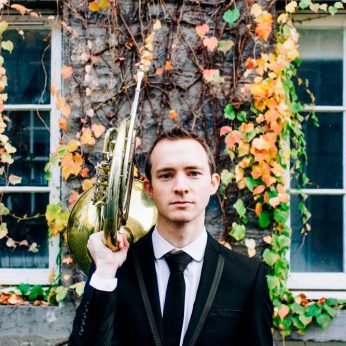Composer: Jean Françaix (b. 1912 - d. 1997)
Performance date: 28/06/2022
Venue: St. Brendan’s Church
Composition Year: 1987
Duration: 00:20:23
Recording Engineer: Simon Cullen, Ergodos
Instrumentation: fl, ob, cl, bn, hn
Instrumentation Category:Wind Quintet
Artists:
Orsino Ensemble (Adam Walker [flute], Emmanuel Laville [oboe], Matt Hunt [clarinet], Alec Frank-Gemmill [horn] Bram van Sambeek [bassoon]) -
[Wind Quintet]

Jean Francaix [1912-1997]
Wind Quintet No.2 [1987]
1. Lento. Allegro
2. Scherzando
3. Ohne Tempobezeichnung
4. Allegrissimo
I was somewhat nervous when the Aulos Wind Quintet asked me for a second quintet. Could I do it again? After all, being 75 is not the same as being 40.
–Jean Francaix
True as this may be, Francaix’s Second Wind Quintet is as delightful and charming as the first Quintet, and indeed the Wind Quartet, his first piece for a wind ensemble written when he was twenty-two. The first movement of the Second Quintet, moving into the second section, displays an energy and franticness that certainly shows the Aulos Wind Quintet were justified in expecting another feat of compositional excellence. Like his previous compositions for wind ensembles, this quintet is a masterpiece of virtuosity and joy.
The opening begins with a rich, highly textured sound, melody upon counter melody, yet delicate and intricate, perfect music for a summer’s day. The second half of the first movement is quick-paced, filled with movement at all levels of the instrumentation, a whirlwind of sound and kinetic energy. The second movement exhibits more contrast between rhythms, melodies and tones from the different instruments. The mood is one of bustle, the music moving forward, until we come to a melody that sounds almost lazy in contrast, the indolent melody constantly being interrupted by faster, more energetic passages. The third movement opens tentatively, an exquisite melody is the main subject, coming forward again and again, soaring above the accompanying parts. The final movement couldn’t be a greater contrast, not only quick paced, but mischievous and witty, requiring extraordinary dexterity from the musicians. The pace changes, led by the horn while the higher register instruments keep the pace alive, fluttering beneath the horn’s sonorous notes, although the sense of being propelled forward returns as the music intensifies and ends in a final flourish.
However old, Francaix never lost his ability to create music with a youthful lightness and energy. The conversational character of the melodies, and how the different parts interweave are an unfailing source of delight to audiences and performers, and one must assume for the composer himself. And if it’s true that you are only as young as you feel, listeners could be forgiven for thinking that Francaix was a carefree twenty-two year old his whole life.
Helen Dawson
Copyright © 2024 West Cork Music. All rights reserved.
Designed and developed by Matrix Internet